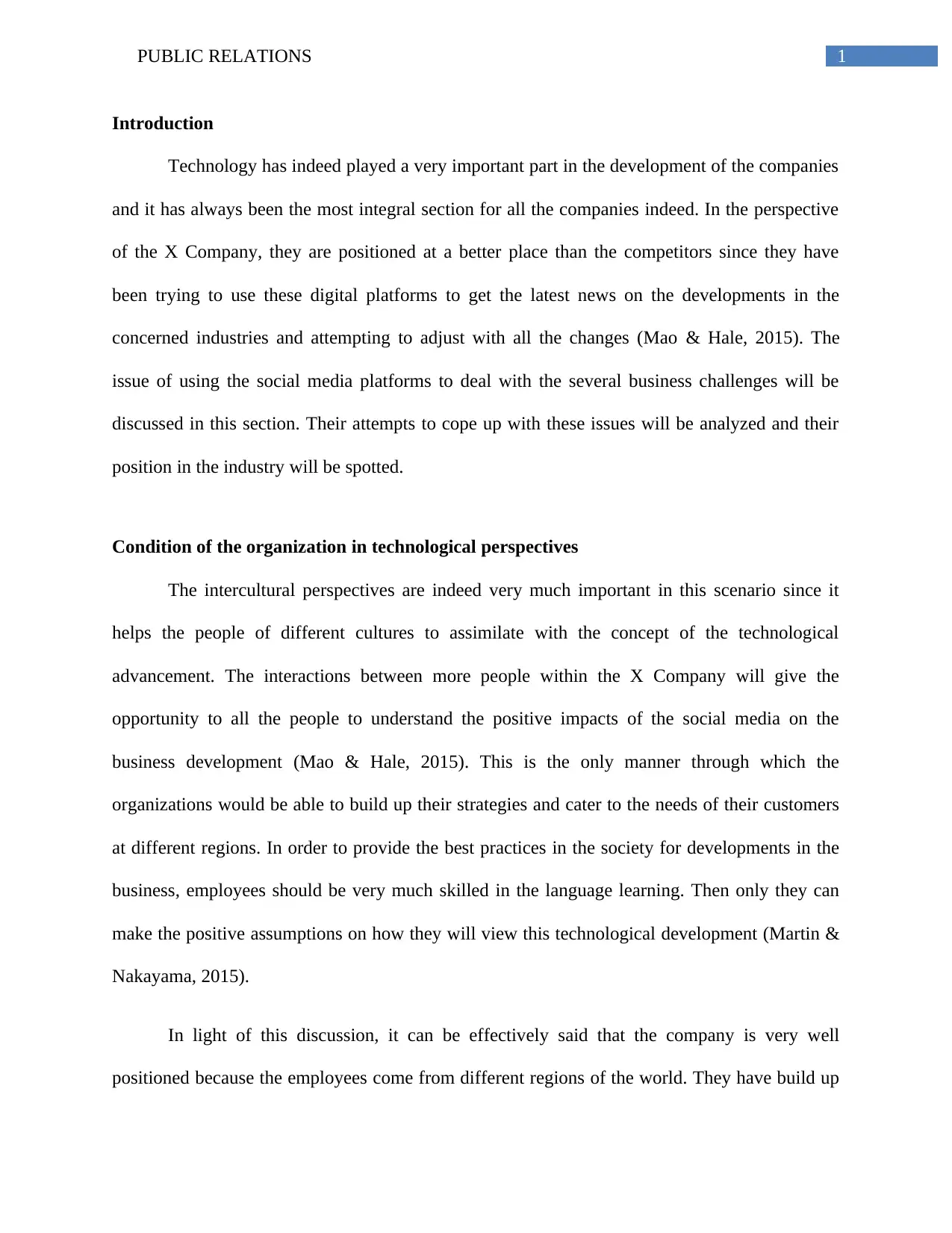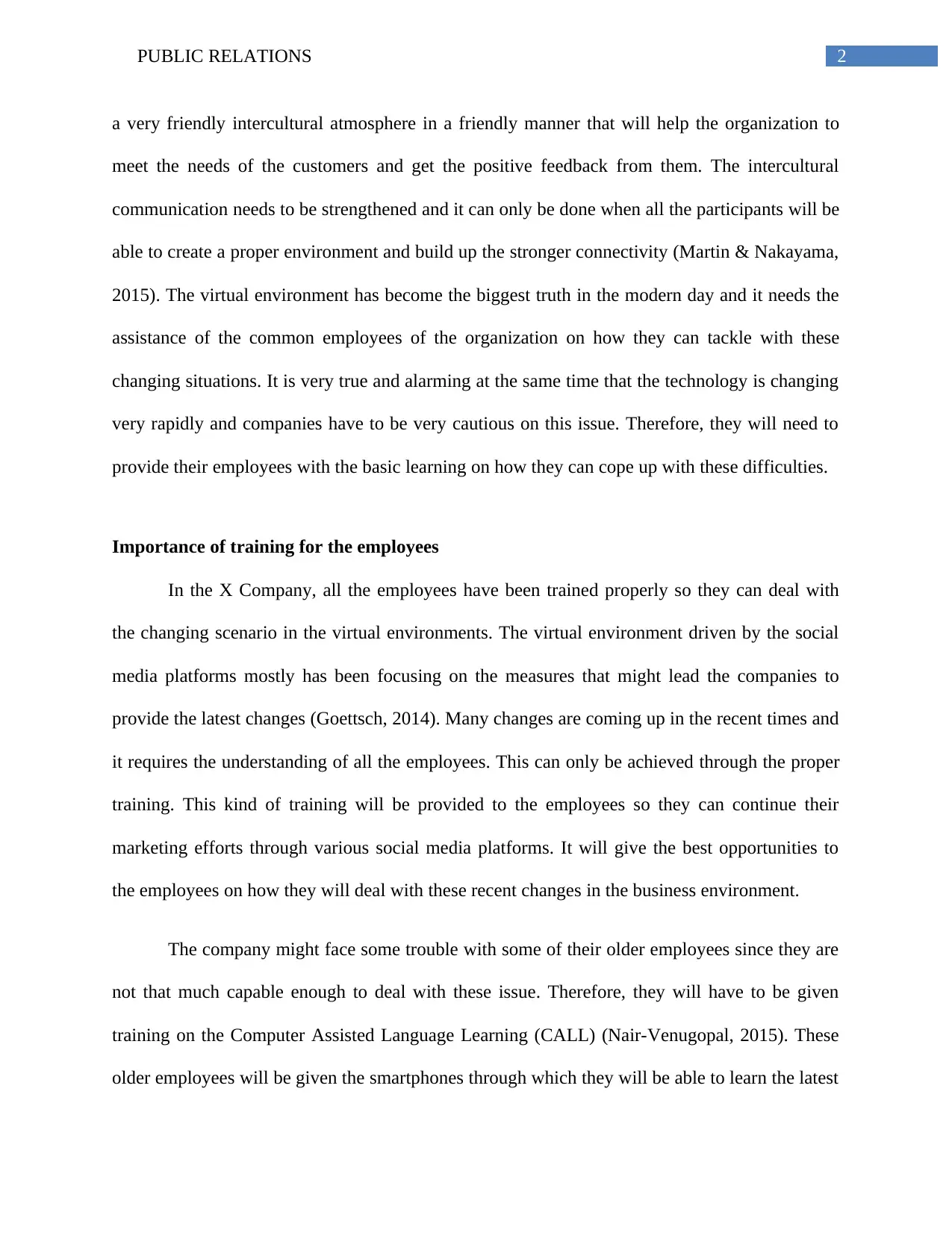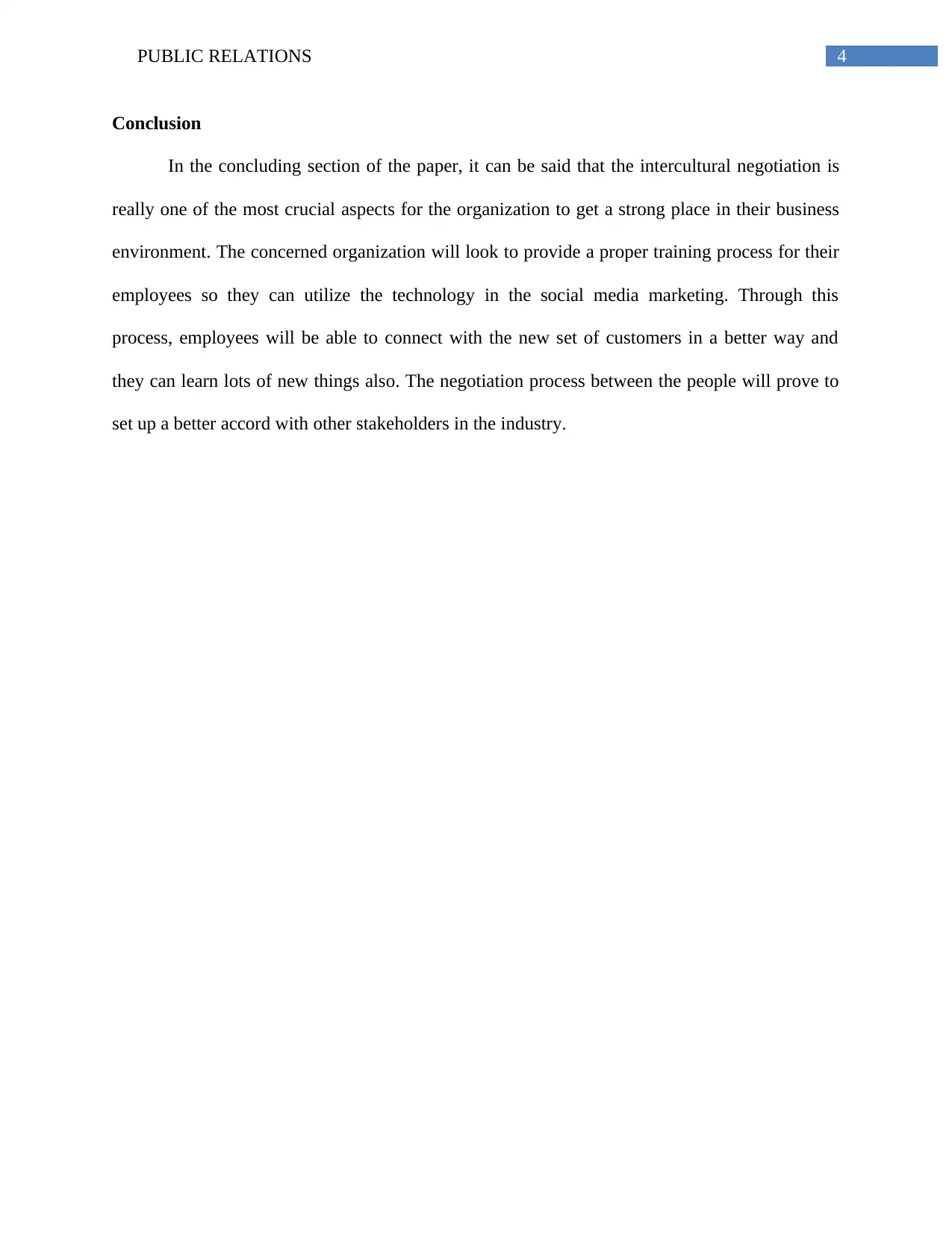Impact of Technology on X Company's Public Relations Strategy
VerifiedAdded on 2022/09/23
|6
|1385
|31
Report
AI Summary
This report provides an analysis of the public relations strategies employed by the X Company, focusing on the impact of technology and intercultural communication. It explores how the company integrates digital platforms and social media to adapt to industry changes and address business challenges. The report emphasizes the importance of intercultural perspectives in a globalized environment, highlighting the need for employee training in language and technology to facilitate effective communication and customer engagement. It examines the company's approach to employee training, particularly in the context of virtual environments and social media marketing. Furthermore, the report discusses intercultural negotiation strategies and how the company strengthens its market position through technological advancements and cultural understanding, concluding with the significance of intercultural negotiation for the company's overall success. The report is supported by academic references to substantiate the analysis of public relations in the context of technology and intercultural communication.

Running head: PUBLIC RELATIONS
Public Relations
Name of the Student
Name of the University
Author Note
Public Relations
Name of the Student
Name of the University
Author Note
Paraphrase This Document
Need a fresh take? Get an instant paraphrase of this document with our AI Paraphraser

1PUBLIC RELATIONS
Introduction
Technology has indeed played a very important part in the development of the companies
and it has always been the most integral section for all the companies indeed. In the perspective
of the X Company, they are positioned at a better place than the competitors since they have
been trying to use these digital platforms to get the latest news on the developments in the
concerned industries and attempting to adjust with all the changes (Mao & Hale, 2015). The
issue of using the social media platforms to deal with the several business challenges will be
discussed in this section. Their attempts to cope up with these issues will be analyzed and their
position in the industry will be spotted.
Condition of the organization in technological perspectives
The intercultural perspectives are indeed very much important in this scenario since it
helps the people of different cultures to assimilate with the concept of the technological
advancement. The interactions between more people within the X Company will give the
opportunity to all the people to understand the positive impacts of the social media on the
business development (Mao & Hale, 2015). This is the only manner through which the
organizations would be able to build up their strategies and cater to the needs of their customers
at different regions. In order to provide the best practices in the society for developments in the
business, employees should be very much skilled in the language learning. Then only they can
make the positive assumptions on how they will view this technological development (Martin &
Nakayama, 2015).
In light of this discussion, it can be effectively said that the company is very well
positioned because the employees come from different regions of the world. They have build up
Introduction
Technology has indeed played a very important part in the development of the companies
and it has always been the most integral section for all the companies indeed. In the perspective
of the X Company, they are positioned at a better place than the competitors since they have
been trying to use these digital platforms to get the latest news on the developments in the
concerned industries and attempting to adjust with all the changes (Mao & Hale, 2015). The
issue of using the social media platforms to deal with the several business challenges will be
discussed in this section. Their attempts to cope up with these issues will be analyzed and their
position in the industry will be spotted.
Condition of the organization in technological perspectives
The intercultural perspectives are indeed very much important in this scenario since it
helps the people of different cultures to assimilate with the concept of the technological
advancement. The interactions between more people within the X Company will give the
opportunity to all the people to understand the positive impacts of the social media on the
business development (Mao & Hale, 2015). This is the only manner through which the
organizations would be able to build up their strategies and cater to the needs of their customers
at different regions. In order to provide the best practices in the society for developments in the
business, employees should be very much skilled in the language learning. Then only they can
make the positive assumptions on how they will view this technological development (Martin &
Nakayama, 2015).
In light of this discussion, it can be effectively said that the company is very well
positioned because the employees come from different regions of the world. They have build up

2PUBLIC RELATIONS
a very friendly intercultural atmosphere in a friendly manner that will help the organization to
meet the needs of the customers and get the positive feedback from them. The intercultural
communication needs to be strengthened and it can only be done when all the participants will be
able to create a proper environment and build up the stronger connectivity (Martin & Nakayama,
2015). The virtual environment has become the biggest truth in the modern day and it needs the
assistance of the common employees of the organization on how they can tackle with these
changing situations. It is very true and alarming at the same time that the technology is changing
very rapidly and companies have to be very cautious on this issue. Therefore, they will need to
provide their employees with the basic learning on how they can cope up with these difficulties.
Importance of training for the employees
In the X Company, all the employees have been trained properly so they can deal with
the changing scenario in the virtual environments. The virtual environment driven by the social
media platforms mostly has been focusing on the measures that might lead the companies to
provide the latest changes (Goettsch, 2014). Many changes are coming up in the recent times and
it requires the understanding of all the employees. This can only be achieved through the proper
training. This kind of training will be provided to the employees so they can continue their
marketing efforts through various social media platforms. It will give the best opportunities to
the employees on how they will deal with these recent changes in the business environment.
The company might face some trouble with some of their older employees since they are
not that much capable enough to deal with these issue. Therefore, they will have to be given
training on the Computer Assisted Language Learning (CALL) (Nair-Venugopal, 2015). These
older employees will be given the smartphones through which they will be able to learn the latest
a very friendly intercultural atmosphere in a friendly manner that will help the organization to
meet the needs of the customers and get the positive feedback from them. The intercultural
communication needs to be strengthened and it can only be done when all the participants will be
able to create a proper environment and build up the stronger connectivity (Martin & Nakayama,
2015). The virtual environment has become the biggest truth in the modern day and it needs the
assistance of the common employees of the organization on how they can tackle with these
changing situations. It is very true and alarming at the same time that the technology is changing
very rapidly and companies have to be very cautious on this issue. Therefore, they will need to
provide their employees with the basic learning on how they can cope up with these difficulties.
Importance of training for the employees
In the X Company, all the employees have been trained properly so they can deal with
the changing scenario in the virtual environments. The virtual environment driven by the social
media platforms mostly has been focusing on the measures that might lead the companies to
provide the latest changes (Goettsch, 2014). Many changes are coming up in the recent times and
it requires the understanding of all the employees. This can only be achieved through the proper
training. This kind of training will be provided to the employees so they can continue their
marketing efforts through various social media platforms. It will give the best opportunities to
the employees on how they will deal with these recent changes in the business environment.
The company might face some trouble with some of their older employees since they are
not that much capable enough to deal with these issue. Therefore, they will have to be given
training on the Computer Assisted Language Learning (CALL) (Nair-Venugopal, 2015). These
older employees will be given the smartphones through which they will be able to learn the latest
⊘ This is a preview!⊘
Do you want full access?
Subscribe today to unlock all pages.

Trusted by 1+ million students worldwide

3PUBLIC RELATIONS
technologies and the power of marketing through the social media (Goettsch, 2014). It is still a
huge concern that the human memories store several incidents in the brain for a long time but it
will become really problematic for them to adjust with all kinds of rapid changes in the
technological concern. The social interactions will have to be made properly and this is the main
process of utilizing the virtual environments (Jackson, 2014). It is the biggest responsibility of
the X Company to provide their employees with the proper training and interact with their
customers through the virtual business environment since the sales rates would grow higher and
they can convince more customers in this process also.
The utilization of the social media has to be done since the information-technology
services are the most integral factors in this scenario. The meetings of the employees also take
place with the headquarters by the assistance of technological devices (Lahti & Valo, 2017). This
is how the company is making its efforts to stay ahead of their rivals to collect the feedbacks
from their customers and device their products and services accordingly.
Intercultural negotiation for company’s position
The positions of the company are very much strengthened as their employees are quietly
adjusting with all these new technologies. These new technologies will increase their skills and
capacities to deal with the several challenges (Jackson, 2014). Through using these technologies,
the company has been able to develop a new set of customers of the young age group. Thus, the
cultures of employees and the customers will mix and this will provide better opportunities for
the company to provide unique services within their customer base (Ladegaard & Jenks, 2015).
This is how the company would establish their strong hold in this competitive business
environment also.
technologies and the power of marketing through the social media (Goettsch, 2014). It is still a
huge concern that the human memories store several incidents in the brain for a long time but it
will become really problematic for them to adjust with all kinds of rapid changes in the
technological concern. The social interactions will have to be made properly and this is the main
process of utilizing the virtual environments (Jackson, 2014). It is the biggest responsibility of
the X Company to provide their employees with the proper training and interact with their
customers through the virtual business environment since the sales rates would grow higher and
they can convince more customers in this process also.
The utilization of the social media has to be done since the information-technology
services are the most integral factors in this scenario. The meetings of the employees also take
place with the headquarters by the assistance of technological devices (Lahti & Valo, 2017). This
is how the company is making its efforts to stay ahead of their rivals to collect the feedbacks
from their customers and device their products and services accordingly.
Intercultural negotiation for company’s position
The positions of the company are very much strengthened as their employees are quietly
adjusting with all these new technologies. These new technologies will increase their skills and
capacities to deal with the several challenges (Jackson, 2014). Through using these technologies,
the company has been able to develop a new set of customers of the young age group. Thus, the
cultures of employees and the customers will mix and this will provide better opportunities for
the company to provide unique services within their customer base (Ladegaard & Jenks, 2015).
This is how the company would establish their strong hold in this competitive business
environment also.
Paraphrase This Document
Need a fresh take? Get an instant paraphrase of this document with our AI Paraphraser

4PUBLIC RELATIONS
Conclusion
In the concluding section of the paper, it can be said that the intercultural negotiation is
really one of the most crucial aspects for the organization to get a strong place in their business
environment. The concerned organization will look to provide a proper training process for their
employees so they can utilize the technology in the social media marketing. Through this
process, employees will be able to connect with the new set of customers in a better way and
they can learn lots of new things also. The negotiation process between the people will prove to
set up a better accord with other stakeholders in the industry.
Conclusion
In the concluding section of the paper, it can be said that the intercultural negotiation is
really one of the most crucial aspects for the organization to get a strong place in their business
environment. The concerned organization will look to provide a proper training process for their
employees so they can utilize the technology in the social media marketing. Through this
process, employees will be able to connect with the new set of customers in a better way and
they can learn lots of new things also. The negotiation process between the people will prove to
set up a better accord with other stakeholders in the industry.

5PUBLIC RELATIONS
References
Goettsch, K. L. (2014). Understanding intercultural communication on global virtual teams:
exploring challenges of language, culture, technology, and collaboration.
Jackson, J. (2014). Introducing language and intercultural communication. Routledge.
Ladegaard, H. J., & Jenks, C. J. (2015). Language and intercultural communication in the
workplace: Critical approaches to theory and practice. Language and Intercultural
Communication, 15(1), 1-12.
Lahti, M., & Valo, M. (2017). Intercultural Workplace Communication. Oxford Research
Encyclopedia of Communication.
Mao, Y., & Hale, C. L. (2015). Relating intercultural communication sensitivity to conflict
management styles, technology use, and organizational communication satisfaction in
multinational organizations in China. Journal of Intercultural Communication
Research, 44(2), 132-150.
Martin, J. N., & Nakayama, T. K. (2015). Reconsidering intercultural (communication)
competence in the workplace: A dialectical approach. Language and Intercultural
Communication, 15(1), 13-28.
Nair-Venugopal, S. (2015). Issues of language and competence in intercultural business
contexts. Language and Intercultural Communication, 15(1), 29-45.
Sorrells, K. (2015). Intercultural communication: Globalization and social justice. Sage
publications.
References
Goettsch, K. L. (2014). Understanding intercultural communication on global virtual teams:
exploring challenges of language, culture, technology, and collaboration.
Jackson, J. (2014). Introducing language and intercultural communication. Routledge.
Ladegaard, H. J., & Jenks, C. J. (2015). Language and intercultural communication in the
workplace: Critical approaches to theory and practice. Language and Intercultural
Communication, 15(1), 1-12.
Lahti, M., & Valo, M. (2017). Intercultural Workplace Communication. Oxford Research
Encyclopedia of Communication.
Mao, Y., & Hale, C. L. (2015). Relating intercultural communication sensitivity to conflict
management styles, technology use, and organizational communication satisfaction in
multinational organizations in China. Journal of Intercultural Communication
Research, 44(2), 132-150.
Martin, J. N., & Nakayama, T. K. (2015). Reconsidering intercultural (communication)
competence in the workplace: A dialectical approach. Language and Intercultural
Communication, 15(1), 13-28.
Nair-Venugopal, S. (2015). Issues of language and competence in intercultural business
contexts. Language and Intercultural Communication, 15(1), 29-45.
Sorrells, K. (2015). Intercultural communication: Globalization and social justice. Sage
publications.
⊘ This is a preview!⊘
Do you want full access?
Subscribe today to unlock all pages.

Trusted by 1+ million students worldwide
1 out of 6
Related Documents
Your All-in-One AI-Powered Toolkit for Academic Success.
+13062052269
info@desklib.com
Available 24*7 on WhatsApp / Email
![[object Object]](/_next/static/media/star-bottom.7253800d.svg)
Unlock your academic potential
Copyright © 2020–2025 A2Z Services. All Rights Reserved. Developed and managed by ZUCOL.





